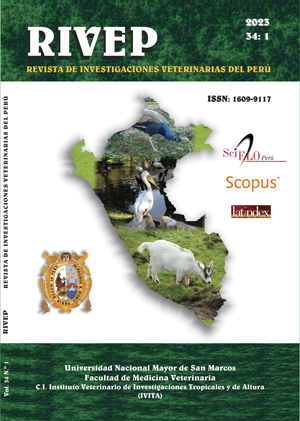Diurnal behavior of bulls grazing on Setaria sphacelata meadows in the high tropics of Oxapampa, Peru
DOI:
https://doi.org/10.15381/rivep.v34i1.24593Keywords:
animal behaviour, grazing, rumination, Setaria sphacelata, bullsAbstract
The aim of this study was to evaluate the influence of the age of bulls at grazing on their diurnal behaviour in Setaria sphacelata meadows. The forage variables were the availability and nutritive value of the diet, and the animal variables were body weight, size and frequency of bites, and diurnal behaviour. Four Brown Swiss x zebu crossed bulls with an initial live weight of 285.8 ± 18.1 kg that grazed in an area of 29 ha (11 paddocks) were selected from a group of 36 bulls. The evaluations were done when the animals reached the ages of 12 (T1), 15 (T2) and 18 (T3) months. A randomized complete block design was used. Forage availability showed differences (p<0.05) between treatments; however, the forage allocation and the nutritional quality of the diet did not compromise their performance. Bite weight was higher in T3 (0.87 ± 0.22 g per bite; p<0.05), but without differences in bite frequency. Grazing activity was similar for T1 (5.09 ± 0.95 h) and T2 (5.38 ± 0.44 h), but lower (p<0.05) for T3 (4.05 ± 0.22 h). Younger bulls (T1) spent less time ruminating, and more time in grazing and other activities. The highest frequency of grazing occurred at the end of the daytime (16:00 to 18:00 h). It is concluded that the age of bull influences their diurnal behaviour, causing older bulls spent less time in grazing and increase the size of bites and rumination time.
Downloads
Downloads
Published
Issue
Section
License
Copyright (c) 2023 Aníbal Rodríguez V., Elmer Meza R., Fritz Trillo Z., Jimny Núñez D., Rolando Azania F.

This work is licensed under a Creative Commons Attribution 4.0 International License.
AUTHORS RETAIN THEIR RIGHTS:
a. Authors retain their trade mark rights and patent, and also on any process or procedure described in the article.
b. Authors retain their right to share, copy, distribute, perform and publicly communicate their article (eg, to place their article in an institutional repository or publish it in a book), with an acknowledgment of its initial publication in the Revista de Investigaciones Veterinarias del Perú (RIVEP).
c. Authors retain theirs right to make a subsequent publication of their work, to use the article or any part thereof (eg a compilation of his papers, lecture notes, thesis, or a book), always indicating the source of publication (the originator of the work, journal, volume, number and date).










